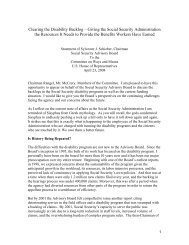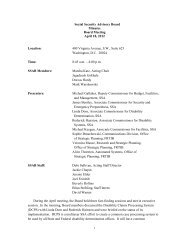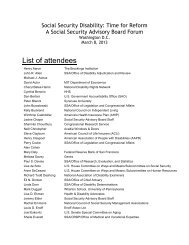Aspects of Disability Decision Making: Data and Materials
Aspects of Disability Decision Making: Data and Materials
Aspects of Disability Decision Making: Data and Materials
You also want an ePaper? Increase the reach of your titles
YUMPU automatically turns print PDFs into web optimized ePapers that Google loves.
ments is equal in severity <strong>and</strong> duration to a listedimpairment.In deciding the medical equivalence, regulationsrequire that adjudicators consider theopinion <strong>of</strong> program physicians or psychologists.A Social Security Ruling (SSR 86-8) was issued in1986 that was designed to clarify the application <strong>of</strong>the “equals” concept. Apart from a slight increasein the number <strong>of</strong> allowances made on the basis <strong>of</strong>equaling the listing in the early 1990s, the number<strong>of</strong> “equals” decisions has remained at less than10 percent <strong>of</strong> all allowance decisions. Failing toestablish that the individual’s impairment meetsor equals the listings does not mean that a claimwill be denied. Benefits may still be awarded if itis found that the reason an individual is not workingis because <strong>of</strong> a severe impairment. Since theseverity <strong>of</strong> the impairment must be the primarybasis for a finding <strong>of</strong> disability, an assessment <strong>of</strong>the individual’s medically-based functional limitations<strong>and</strong> remaining capacities must be completedbefore a decision can be rendered at step 4 or step 5<strong>of</strong> the sequential evaluation process.Residual Functional Capacity (RFC) is anadministrative assessment requiring a thoroughanalysis <strong>of</strong> all relevant evidence. The purpose <strong>of</strong>the RFC assessment is to determine the extent towhich the individual’s impairment(s) reduces theability to engage in specific work-related physical<strong>and</strong>/or mental functions. This residual capacityassessment is meant to reflect the most a personcan do, despite any limitations. <strong>Disability</strong> examinersmay participate <strong>and</strong> have input into the RFCassessment at the initial <strong>and</strong> reconsideration level;however, regulations provide that program physiciansor psychologists are responsible for theactual completion <strong>of</strong> the RFC. 4When establishing the RFC, the adjudicatormust consider limitations <strong>and</strong> restrictions imposedby all <strong>of</strong> the individual’s impairments includingany that are considered to be not severe. Whilea “not severe” impairment, by itself, would nothave more than a minimal impact on work-relatedfunction, it could, when considered in combinationwith other severe impairments, reduce therange <strong>of</strong> work an individual could do at all or preventan individual from performing past work.Adjudicator conclusions about an individual’sfunctional ability must be supported by specificmedical facts. Statements from the individual or4In the 10 prototype DDSs, “single decision maker” disabilityexaminers are permitted to adjudicate most cases without am<strong>and</strong>atory concurrence by a doctor. SSI child cases <strong>and</strong> casesinvolving a mental impairment may not be adjudicated without adoctor’s concurrence.others about functioning must also be considered<strong>and</strong> any inconsistencies must be resolved orexplained. The RFC assessment must include awritten explanation <strong>of</strong> why any symptoms, suchas pain, that result in limitations can or cannot bereasonably accepted as consistent with the medicalevidence. Medical source opinions must be considered<strong>and</strong> discussed in the RFC assessment <strong>and</strong>primary importance must be given to any opinionexpressed by the individual’s treating source.When a treating source gives an opinion that discussesthe consequences or the implications <strong>of</strong> anindividual’s impairment <strong>and</strong> the opinion is supportedby the medical evidence, it must be givencontrolling weight by the adjudicator.The adjudicator must arrive at a conclusionthat expresses the individual’s physical capacityfor such activities as walking, st<strong>and</strong>ing, lifting <strong>and</strong>carrying. In cases involving mental impairments,adjudicators have to consider such capabilities asthe individual’s ability to underst<strong>and</strong>, to carryout <strong>and</strong> remember instructions, <strong>and</strong> to respondappropriately to supervision, coworkers, <strong>and</strong> workpressures.4. Can the individual, despite any functionallimitations imposed by a severe impairment,perform work that he or she did in the past?Once the RFC assessment is completed, adetermination must be made as to whether, consideringthe impairment-induced functional loss,the individual retains the capability to performrelevant work that he or she has done in the past15 years. At this step, the vocational issues arenarrow <strong>and</strong> do not consider the effect <strong>of</strong> age oreducational level. If the adjudicator determinesthat the individual is able to meet the physical <strong>and</strong>mental dem<strong>and</strong>s <strong>of</strong> any prior work, a finding willbe made that the individual is not disabled irrespective<strong>of</strong> age or education.If it is determined that the individual does nothave the functional capacity to perform past relevantwork, the adjudicator moves on to the fifth<strong>and</strong> final step <strong>of</strong> the process.5. Can the individual do any other type <strong>of</strong> work?At step 5, the burden is on the Social SecurityAdministration to determine whether, given theindividual’s functional abilities, there are sufficientjobs in the national economy that the person canperform. Using the RFC assessment, the adjudicatorconsults SSA’s medical-vocational guidelines,commonly known as the vocational grids. The<strong>Aspects</strong> <strong>of</strong> <strong>Disability</strong> <strong>Decision</strong> <strong>Making</strong>: <strong>Data</strong> <strong>and</strong> <strong>Materials</strong> 85









